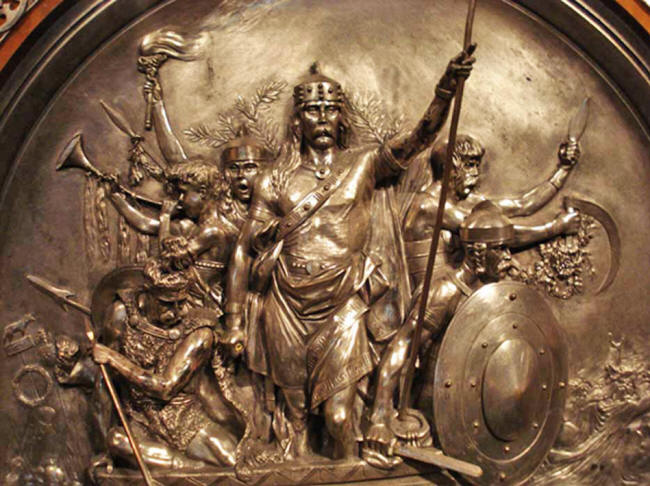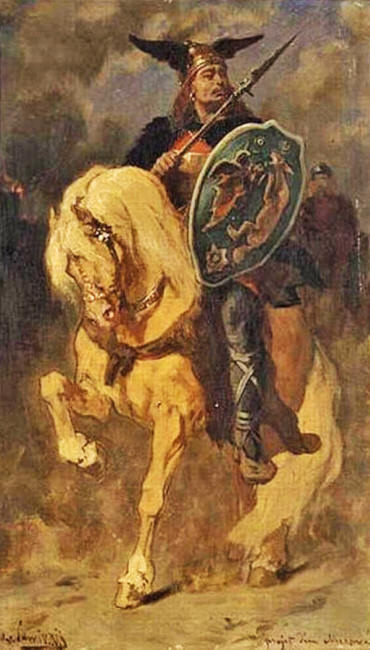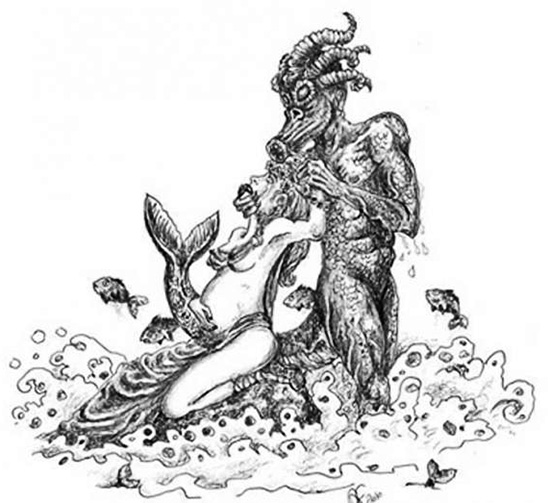|

by Carly Silver
Updated
February 19, 2022
from
Ancient-Origins Website
Spanish version
Italian version

Silvered brass mounting
from 1867 depicting
Merovech victorious in battle,
by Emmanuel Frémiet.
Source: CC BY SA 3.0
You've probably heard of
a Minotaur (half-man, half-bull), but what about a Quinotaur?
In early
Frankish history there was a "beast
of Neptune" which was said to look like a creature called a
Quinotaur.
This mysterious mythical
being only appeared in one text, but he was said to have fathered a
line of kings whose descendants still survive today, and they even
made an appearance in The Da Vinci Code.
Merovech,
Founder of the Merovingians
This story involved the Franks, a Germanic tribe whose descendants
eventually migrated to and ruled parts of what is now modern France,
Germany, and Belgium.
In a history of the
Frankish people , the cleric
Fredegar attributed the
founding of its ruling dynasty, the Merovingians, to one guy named
Merovech.
Gregory of Tours was the first
source to mention
Merovech.
But he doesn't give
Merovech a monstrous lineage, instead making him a mortal man who
founded a new royal dynasty.

Merovech,
founder
of the Merovingians.
(
Public Domain )
A Descendant
of Chlodio?
Gregory stressed the accomplishments of his descendants, including
his son Childeric, rather than giving him any illustrious ancestors.
Merovech might be related to a prior king named
Chlodio, but it's not
confirmed.
What does this mean?
Perhaps Merovech wasn't of noble lineage, but was instead a
self-made man; either way, it seems that Merovech's descendants were
of more historical significance than his ancestors.
Other sources, like the
anonymously-penned Liber Historiae Francorum (Book of the
History of the Franks ), explicitly identify Merovech as being
related to Chlodio.
But the aforementioned
Fredegar goes a different route.
He says that Chlodio's
wife gave birth to Merovech, but her husband wasn't the father;
instead, she decided to go swimming and, in the water, mated with a
mysterious monster a,
"beast of Neptune
which resembles a Quinotaur."
As a result, Merovech was
the son either of a mortal king or a magical beast.

A quinotaur sea monster
possessing king Clodio's wife,
who
became pregnant with
the
future king Merovech.
Created
by Andrea Farronato.
(Public
Domain)
Who, or What,
was a Quinotaur?
Other than the etymological similarity it bears to "Minotaur,"
another famous beast, Fredergar's is the sole reference to Quinotaur
in history, so we don't have any real means of comparison.
Some scholars have
suggested that "Quinotaur" was a misspelling of "Minotaur."
Bulls weren't particularly prominent in Franco-Germanic myths, so
it's suggested that this creature was of Latin inspiration.
Indeed, even by that time
there was a long tradition of casting the Franks as heirs to the
classical Mediterranean (and thus as legitimate heirs of the
Romans).
After the
Trojan War, the Trojans and their
allies reportedly fled to the Rhine, where their descendants
eventually became the Franks.

Is quinotaur
just a
misspelling of minotaur (pictured)?
(Public
Domain)
Why did
Fredegar Suggest that Merovech had a Mythical Sea Creature as a
Father?
Perhaps Fredegar was elevating Merovech to hero status.
A semi-mythical ancestry
was a characteristic of many mythological heroes; think of, for
example, the Greek king Theseus of Athens, who claimed both the sea
god Poseidon and the mortal king Aegeus as his father.
In other words, having a
sea monster father made Merovech - and his real-life descendants,
living and ruling during the times of Gregory and Fredegar -
different from those they ruled over, perhaps as demigods or, at
least, divinely ordained.
Some historians have suggested the Merovingians were indeed thought
of as "sacred kings," somehow more than mortal, men that were holy
in and of themselves.
The kings would be
special, perhaps invincible in battle.
The authors of
Holy Blood, Holy Grail , who
posited that the Merovingians were descended from Jesus -
whose hidden bloodline migrated from Israel to France via Mary
Magdalene - were big proponents of this theory.
Other scholars have
suggested that this tale was an attempt to parse out the name "Merovech,"
assigning it a meaning of "sea bull," or some such.
Rather than understanding the Quinotaur as a mythological
justification for the Merovingians being sacred kings, some think
the issue is much simpler.
If Merovech was Chlodio's
son by his wife, then he was just your average king - nothing
special. And if Chlodio's queen had a child by a man who was neither
her husband nor a mythical sea creature, then Merovech was
illegitimate.
Rather than specifying that a mythical creature fathered Merovech,
maybe the chronicler deliberately left the king's parentage - and
thus the ancestry of his son, Childeric - ambiguous because, as
British Ian Wood wrote in an article,
"there was nothing
special about Childeric's birth"...
References
-
Baigen, Michael,
Richard Leigh, and Henry Lincoln. Holy Blood, Holy Grail:
The Secret History of Christ & The Shocking Legacy of the
Grail . New York: Delta, 1983.
-
Bitel, Lisa M.
Women in Early Medieval Europe, 400-1100. New York:
Cambridge University Press, 2002.
-
Collins, Roger. "Fredegar."
Authors of the Middle Ages . Ed. Patrick J. Geary. Volume
IV, Nos. 12–13. Brookfield, VT: Ashgate, 1996.
-
Halsall, Guy.
Cemeteries in Society in Merovingian Gaul: Selected Studies
in History and Archaeology, 1992–2009 . Boston, MA: Brill,
2010.
-
Jones, Allen E.
Social Mobility in Late Antique Gaul: Strategies and
Opportunities for the Non-Elite. New York: Cambridge
University Press, 2009.
-
Murray, Alexander
Callander. "Post vocantur Merohingii: Fredegar, Merovech,
and 'sacral kingship'." After Rome's Fall: Narrators and
Sources of Early Medieval History . Ed. Alexander Callander
Murray. Buffalo, New York: University of Toronto Press,
1998. 121-152.
-
Nelson, Janet L.
Frankish World, 750-900. Rio Grande, OH: The Hambledon
Press, 1996.
-
Reimitz, Helmut.
History, Frankish Identity and the Framing of Western
Ethnicity, 550–850 . New York: Cambridge University Press,
2015.
-
Wood, Ian N..
"Deconstructing the Merovingian Family." The Construction of
Communities in the Early Middle Ages . Texts, Resources and
Artefacts. Ed. Richard Corradini, Maximilian Diesenberger,
and Helmut Reimitz. Boston, MA: Brill, 2003. 149-172.
-
"Fredegar's
Fables." Historiographie im frühen Mittelalter . Ed.
Anton Scharer and Georg Scheibelreiter, Wien: Oldenbourg,
1994. 359-366.
-
The
Merovingian Kingdoms: 450-751 . New York: Routledge,
2014.
|





